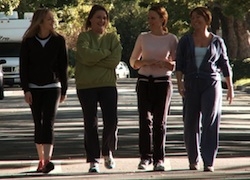 It seems like every day a new web series launches, so content creators are continually trying to think of ways to distinguish their content from the rest. And with the one-to-one nature of the web, adding an interactive element seems like a logical step in personalizing the story and bringing the characters to life. So, I was intrigued when I heard about the launch of Chapin Circle, a new female-focused web series centering around the lives of four women living in Midwestern suburbia that boasts what the show’s creator, Michele Palermo, calls a revolutionary patent-pending “Character Selection” option that she touts “might just be the future of Internet TV.” According to Palermo, the Character Selection option is a way for viewers “to tailor their experience to the character they want to watch–without ever losing the scope of the show as a whole.”
It seems like every day a new web series launches, so content creators are continually trying to think of ways to distinguish their content from the rest. And with the one-to-one nature of the web, adding an interactive element seems like a logical step in personalizing the story and bringing the characters to life. So, I was intrigued when I heard about the launch of Chapin Circle, a new female-focused web series centering around the lives of four women living in Midwestern suburbia that boasts what the show’s creator, Michele Palermo, calls a revolutionary patent-pending “Character Selection” option that she touts “might just be the future of Internet TV.” According to Palermo, the Character Selection option is a way for viewers “to tailor their experience to the character they want to watch–without ever losing the scope of the show as a whole.”
Episode 1 was a bit slow moving, and while I often consume long form content online, it felt longer than 10 minutes, taking an interminable amount of time to set up the characters. Sort of a G-rated version of Desperate Housewives meets Lifetime special, it follows four generations of women who are endearing enough, if not somewhat predictable. You’ve got the dramatic, bride-to-be 20-something, Heather (Rachael Sheridan), having relationship issues with her doctor fiancé, the spirited 30-something school teacher, Annie (Lolly Howe), more passionate about her students than her docile husband (who you fellow Gen-Xers will recognize from the original Beverly Hills 90210), the 40-something ex-lawyer, Becca (Palermo), dissatisfied with her appearance and having misgivings about her decision to be a stay-at-home mom and the 50-something outspoken menopausal woman, Susan, juggling a career, a husband who doesn’t notice her anymore and a 16-year old daughter’s teenage angst.

Subscribe for daily Tubefilter Top Stories
The production value is high but it definitely feels like it’s mimicking TV, a hybrid daytime/primetime soap opera covering the gamut of overly dramatized situations like when Annie is fiercely adamant about not giving up her student to the school’s principal, citing the first amendment, or when Becca storms off when her investment banker husband is too tired to take her out to the theatre. Even Heather babysitting Becca’s kids, who are stomping their feet and screaming like Children of the Corn, is a tad melodramatic, leading up to a moment where she and fiancé, Eric, gleefully swear off having children as a result. But the Chapin Circle creators don’t seem to be shrouding that fact since their goal is to become the premier Internet television show for women, inspired by “the way TV used to be,” and capitalizing on an audience that unapologetically enjoys daytime dramas, has a minivan and 2.5 kids and spends most of their time online.
 Palermo says that she developed the show in response to the fact that women have increasingly less time to watch traditional TV. “Most of my friends no longer watch TV–they’re too tired at the end of a day to wade through hooks and gimmicks to find a character they can relate to,” she explained. “They’d rather spend those 30 ‘me-time’ minutes taking a bath. But they all log on to the Internet every day…What if their Internet time could translate to ‘me-time?’ If there was a great narrative television show with episodes brief enough to view on the Web, but substantial enough to entertain them, perhaps even inspire them–about people who look and live like they do–maybe they’d tune in.”
Palermo says that she developed the show in response to the fact that women have increasingly less time to watch traditional TV. “Most of my friends no longer watch TV–they’re too tired at the end of a day to wade through hooks and gimmicks to find a character they can relate to,” she explained. “They’d rather spend those 30 ‘me-time’ minutes taking a bath. But they all log on to the Internet every day…What if their Internet time could translate to ‘me-time?’ If there was a great narrative television show with episodes brief enough to view on the Web, but substantial enough to entertain them, perhaps even inspire them–about people who look and live like they do–maybe they’d tune in.”
In that respect, Chapin Circle, has definitely built something relatable to their core target which they may be able to parlay into a solid slice of the market, appealing to the female head of household decision-maker that is highly coveted by advertisers. I could envision consumer packaged goods woven into the show with coupon codes or eCommerce pull-through for products featured. And it certainly seems like the type of series that Target or JC Penney might sponsor. It seems they may be thinking along those lines as well as they are actively seeking sponsorship, holding off on the release of episodes 3-5 until they secure funding. It’s an interesting approach releasing only 2 episodes, the second of which will be available this Saturday, 10/10, as a way to build initial viewership and spotlight the content for those trying to reach the targeted demographic — a digital upfront of sorts that allows potential advertisers to see the series on spec to assess if they want to invest in it.
Content and advertising opportunities aside, I was slightly disappointed with the Character Selection vignettes which Palermo says “complements each full episode of the show with four mini-episodes that allow viewers to tailor their experience to the character they want to watch–without ever losing the scope of the show as a whole.” With that description, I was expecting to see the episode I’d just watched literally through the eyes of each character, with their unique perspectives on the events that had unfolded, when in actuality, it appears to be little more than just each character’s scenes extracted from the whole, stitching it loosely together with only the opening scene containing all four characters on their ritual morning walk. Granted, I only saw one episode, so perhaps they’re framing the initial context before adding in more interactive features that better set the tone of each character’s viewpoint, but it seems to me that if I were to just watch the abbreviated character-specific versions, I’d miss what was happening with the other characters.
Heather’s vignette, for example, only showed the scenes she was in, so I got to see her interpersonal relationships with the people with whom she interacted directly, but I didn’t get to see anything that was happening in Annie, Becca or Susan’s lives, so I struggle with Palermo’s claim that if “you’re only interested in one character–you can watch just that character’s story and still experience the full dramatic engagement of the show.” How would I learn about Annie’s struggles with the school board over her Journalism 2.0 project or Susan’s husband’s medical issues unless I watched the full multi-character episode? Seems the character videos just tell an isolated story without weaving all of the storylines together for a complete picture of what’s happening.
 I do believe that cooperative entertainment is the future, but few are executing it well. FOX’s attempt at participatory TV viewing was a colossal failure, overlaying tweets on the screen that disrupted the viewing experience and weren’t interactive at all. And most network forays into this area are in the form of slapping up an info-frame around the content that’s a more of a distraction than true engagement. So, those who can create compelling vehicles through which viewers can interact with their favorite characters or get more involved with the storyline, are poised to take a leadership role. And series like Valemont and Heroes‘ multi-platform initiative are showing great promise by bringing story elements to life and giving users bonus content to explore and actively participate with rather than being a passive viewer merely watching events unfold.
I do believe that cooperative entertainment is the future, but few are executing it well. FOX’s attempt at participatory TV viewing was a colossal failure, overlaying tweets on the screen that disrupted the viewing experience and weren’t interactive at all. And most network forays into this area are in the form of slapping up an info-frame around the content that’s a more of a distraction than true engagement. So, those who can create compelling vehicles through which viewers can interact with their favorite characters or get more involved with the storyline, are poised to take a leadership role. And series like Valemont and Heroes‘ multi-platform initiative are showing great promise by bringing story elements to life and giving users bonus content to explore and actively participate with rather than being a passive viewer merely watching events unfold.
Through the web and mobile devices, you can reach users at the point of consumption, so interactive elements can play a major role in enriching a story, and with the increasing prominence of geo-targeting and location aware apps, customizing content within the context of viewers’ personal lives, opens up a floodgate of possibilities. Imagine unlocking content ‘on location’ or finding clues at your neighborhood coffee shop. We haven’t even begun to scratch the surface of extending content to the full potential that multi-device convergence offers, but I’m happy to see content creators beginning to think along these lines, and formulating ways to add layers to the experience. In an undefined space, it may take a lot of trial and error to find a formula that works, but it requires at least trying something. And Chapin Circle is blazing an unchartered trail, which they will hopefully fine-tune as the story evolves.
So, while it doesn’t appear that Chapin Circle will be revolutionizing interactive television quite yet, it does deliver solid narrative and a believable cast of characters facing everyday trials representative of mainstream America. And for whom I can see many women finding a connection. If Chapin Circle continues in the direction of finding interactive angles for delivering their content in a meaningful way, they may stumble upon the types of character relationships that spark lasting affinity. And cultivate viewers who reach for the laptop, instead of the remote.








